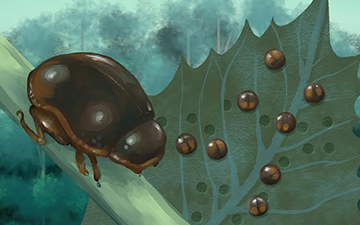Flea beetle is a general name applied to the small, jumping beetles of the leaf beetle family(Chrysomelidae). They make up the tribe Alticini, which is a part of the subfamily Galerucinae, though they were historically classified as a subfamily in their own right. Though most tribes of the Galerucinae are suspect of rampant paraphyly in the present delimitation, the Alticini seem to form a good clade at least for the most part.
The adults are very small to moderately sized Chrysomelidae (i.e. among beetles in general they are on the smallish side). They are similar to other leaf beetles, but characteristically have the hindleg femoragreatly enlarged. These enlarged femora allow for the springing action of these insects when disturbed. Flea beetles can also walk normally and fly. Many flea beetles are attractively coloured; dark, shiny and often metallic colors predominate.
Adult flea beetles feed externally on plants, eating the surface of the leaves, stems and petals. Under heavy feeding the small round holes caused by an individual flea beetle’s feeding may coalesce into larger areas of damage. Some flea beetle larvae (e.g. of Phyllotreta species) are root feeders.
In adverse weather conditions (rain, for example) some flea beetles seek shelter in the soil. Some species, such as Phyllotreta cruciferaeand P. striolata, prefer to leave their hideouts only during warm and dry weather. The German name Erdflöhe (literally “earth fleas“) refers to their jumping ability and this behavior of hiding in the soil.
(From Wikipedia, August 2015)




